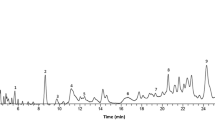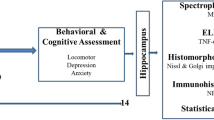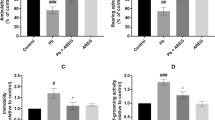Abstract
Carvacrol is a monoterpene with neuroprotective effects in several animal models of neurodegeneration, including epilepsy, ischemia, and traumatic neuronal events. In this study, we aimed to examine the effects of carvacrol on neurodegeneration induced by lead acetate in rats. A total of 50 male Wistar rats were divided into five equal groups. The control group received drinking water, while the neurotoxic group was exposed to 500 ppm of lead acetate in drinking water for 40 days. The three remaining groups, which were also exposed to 500 ppm of lead acetate, received carvacrol at doses of 25, 50, and 100 mg/kg orally for 40 days. The Morris water maze test was employed to examine spatial learning and memory. Pathological damage to the hippocampus was determined by Nissl staining. The level of malondialdehyde (MDA), superoxide dismutase (SOD), and catalase (CAT) were detected using biochemical analysis and the free radical scavenging activity as evaluated by the DPPH test. Administration of carvacrol significantly restored learning and memory impairment induced by lead acetate. Moreover, carvacrol ameliorated neurodegeneration, antioxidative capacity, and lipid peroxidation in the hippocampus of rats exposed to lead. The present results provide a rationale for the inhibitory role of carvacrol in the attenuation of lead-induced neurotoxicity.











Similar content being viewed by others
References
Ahamed M, Siddiqui M (2007) Low level lead exposure and oxidative stress: current opinions. Clin Chim Acta 383:57–64
Alagawany M, El-hack MA, Farag MR, Tiwari R, Dhama K (2015) Biological effects and modes of action of carvacrol in animal and poultry pro-duction and health-a review. Advances in Animal and Veterinary Sciences 3:73–84
Aski ML, Rezvani ME, Khaksari M, Hafizi Z, Pirmoradi Z, Niknazar S, Mehrjerdi FZ (2018) Neuroprotective effect of berberine chloride on cognitive impairment and hippocampal damage in experimental model of vascular dementia. Iranian journal of basic medical sciences 21:53
Badavi M, Mehrgerdi FZ, Sarkaki A, Naseri M, Dianat M (2008) Effect of grape seed extract on lead induced hypertension and heart rate in rat. Pak J Biol Sci 11:882–887
Baranowska-bosiacka I, Strużyńska L, Gutowska I, Machalińska A, Kolasa A, Kłos P, Czapski G, Kurzawski M, Prokopowicz A, Marchlewicz M (2013) Perinatal exposure to lead induces morphological, ultrastructural and molecular alterations in the hippocampus. Toxicology 303:187–200
Chiodo LM, COVINGTON C, SOKOL RJ, HANNIGAN JH, JANNISE J, AGER J, GREENWALD M, DELANEY-BLACK V (2007) Blood lead levels and specific attention effects in young children. Neurotoxicol Teratol 29:538–546
Deng W, Lu H, Teng J (2013) Carvacrol attenuates diabetes-associated cognitive deficits in rats. J Mol Neurosci 51:813–819
Haleagrahara N, JACKIE T, CHAKRAVARTHI S, RAO M, PASUPATHI T (2010) Protective effects of Etlingera elatior extract on lead acetate-induced changes in oxidative biomarkers in bone marrow of rats. Food Chem Toxicol 48:2688–2694
Kang JK, SUL D, KANG JK, NAM S-Y, KIM H-J, LEE E (2004) Effects of lead exposure on the expression of phospholipid hydroperoxidase glutathione peroxidase mRNA in the rat brain. Toxicol Sci 82:228–236
Karamian R, KOMAKI A, SALEHI I, TAHMASEBI L, KOMAKI H, SHAHIDI S, SARIHI A (2015) Vitamin C reverses lead-induced deficits in hippocampal synaptic plasticity in rats. Brain Res Bull 116:7–15
Koller K, BROWN T, SPURGEON A, LEVY L (2004) Recent developments in low-level lead exposure and intellectual impairment in children. Environ Health Perspect 112:987–994
Li N, LIU F, SONG L, ZHANG P, QIAO M, ZHAO Q, LI W (2014) The effects of early life Pb exposure on the expression of IL1-β, TNF-α and Aβ in cerebral cortex of mouse pups. J Trace Elem Med Biol 28:100–104
Liu M-C, XU Y, CHEN Y-M, LI J, ZHAO F, ZHENG G, JING J-F, KE T, CHEN J-Y, LUO W-J (2013) The effect of sodium selenite on lead induced cognitive dysfunction. Neurotoxicology 36:82–88
Liu F, XUE Z, LI N, HUANG H, YING Y, LI J, WANG L, LI W (2014) Effects of lead exposure on the expression of amyloid β and phosphorylated tau proteins in the C57BL/6 mouse hippocampus at different life stages. J Trace Elem Med Biol 28:227–232
Mehrjerdi FZ, ABOUTALEB N, HABIBEY R, AJAMI M, SOLEIMANI M, ARABIAN M, NIKNAZAR S, DAVOODI SH, PAZOKI-TOROUDI H (2013) Increased phosphorylation of mTOR is involved in remote ischemic preconditioning of hippocampus in mice. Brain Res 1526:94–101
Needleman H (2009) Low level lead exposure: history and discovery. Ann Epidemiol 19:235–238
Pirmoradi Z, YADEGARI M, MORADI A, KHOJASTEH F, MEHRJERDI FZ (2019) Effect of berberine chloride on caspase-3 dependent apoptosis and antioxidant capacity in the hippocampus of the chronic cerebral hypoperfusion rat model. Iranian journal of basic medical sciences 22:154
Prasanthi RJ, DEVI CB, BASHA DC, REDDY NS, REDDY GR (2010) Calcium and zinc supplementation protects lead (Pb)-induced perturbations in antioxidant enzymes and lipid peroxidation in developing mouse brain. Int J Dev Neurosci 28:161–167
Samarghandian S, FARKHONDEH T, SAMINI F, BORJI A (2016, 2016) Protective effects of carvacrol against oxidative stress induced by chronic stress in rat’s brain, liver, and kidney. Biochemistry research international
Sánchez-martín FJ, FAN Y, LINDQUIST DM, XIA Y, PUGA A (2013) Lead induces similar gene expression changes in brains of gestationally exposed adult mice and in neurons differentiated from mouse embryonic stem cells. PLoS One 8:e80558
Sánchez-martín, F. J., LINDQUIST, D. M., LANDERO-FIGUEROA, J., ZHANG, X., CHEN, J., CECIL, K. M., MEDVEDOVIC, M. & PUGA, A. 2015. Sex-and tissue-specific methylome changes in brains of mice perinatally exposed to lead. Neurotoxicology, 46, 92–100
Sanders T, LIU Y, BUCHNER V, TCHOUNWOU PB (2009) Neurotoxic effects and biomarkers of lead exposure: a review. Rev Environ Health 24:15–46
Shafahi M, VAEZI G, SHAJIEE H, SHARAFI S, KHAKSARI M (2018) Crocin inhibits apoptosis and astrogliosis of hippocampus neurons against methamphetamine neurotoxicity via antioxidant and anti-inflammatory mechanisms. Neurochem Res 43:2252–2259
Sharifi-rad M, VARONI EM, IRITI M, MARTORELL M, SETZER WN, DEL MAR CONTRERAS M, SALEHI B, SOLTANI-NEJAD A, RAJABI S, TAJBAKHSH M (2018) Carvacrol and human health: A comprehensive review. Phytother Res 32:1675–1687
Sun B, ZHANG X, YIN Y, SUN H, GE H, LI W (2017) Effects of sulforaphane and vitamin E on cognitive disorder and oxidative damage in lead-exposed mice hippocampus at lactation. J Trace Elem Med Biol 44:88–92
Tchounwou, P. B., YEDJOU, C. G., PATLOLLA, A. K. & SUTTON, D. J. 2012. Heavy metal toxicity and the environment. Molecular, clinical and environmental toxicology. Springer
Verina T, ROHDE CA, GUILARTE TR (2007) Environmental lead exposure during early life alters granule cell neurogenesis and morphology in the hippocampus of young adult rats. Neuroscience 145:1037–1047
Wang P, LUO Q, QIAO H, DING H, CAO Y, YU J, LIU R, ZHANG Q, ZHU H, QU L (2017) The neuroprotective effects of carvacrol on ethanol-induced hippocampal neurons impairment via the antioxidative and antiapoptotic pathways. Oxidative medicine and cellular longevity:2017
Yu H, ZHANG Z-L, CHEN J, PEI A, HUA F, QIAN X, HE J, LIU C-F, XU X (2012) Carvacrol, a food-additive, provides neuroprotection on focal cerebral ischemia/reperfusion injury in mice. PLoS One 7:e33584
Funding
This study was supported by grant No: 5458 from the Neurobiomedical Research Center, School of Medicine, Shahid Sadoughi University of Medical Sciences and Health Services.
Author information
Authors and Affiliations
Contributions
FZ and MK conceived and designed the research; SN, MY, FA, and ZP conducted the experiments and analyzed the data. FA and ZP conducted viability experiments and analyzed the data. FZ, MK, SN, and MY interpreted results. FZ, MK, and MY wrote the manuscript. All the authors read and approved the manuscript.
Corresponding author
Ethics declarations
Conflict of interest
No potential conflict of interest was reported by the authors.
Ethical approval
All procedures were performed in accordance with the National Institutes of Health Guidelines for the Care and Use of Laboratory Animals and were approved in the ethics committee (IR.SSU.MEDICINE.REC.1396.317).
The experimental investigation we would have wished to perform, in order to further and convincingly support the unprecedentedly strong effects of carvacrol, would be a blinded qPCR analysis of catalase and SOD transcription in lysates of all frozen animal brains. However, this was not possible for us, as economic sanctions that are in effect on us from outside of the scientific arena, unfortunately, made such investigations impossible. We will immediately catch up with such confirmation testing as soon as routine qPCR analysis will again be doable for us.
Additional information
Publisher’s note
Springer Nature remains neutral with regard to jurisdictional claims in published maps and institutional affiliations.
Rights and permissions
About this article
Cite this article
Zare Mehrjerdi, F., Niknazar, S., Yadegari, M. et al. Carvacrol reduces hippocampal cell death and improves learning and memory deficits following lead-induced neurotoxicity via antioxidant activity. Naunyn-Schmiedeberg's Arch Pharmacol 393, 1229–1237 (2020). https://doi.org/10.1007/s00210-020-01866-6
Received:
Accepted:
Published:
Issue Date:
DOI: https://doi.org/10.1007/s00210-020-01866-6




